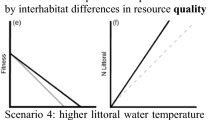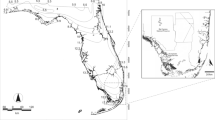Abstract
Environmental factors, such as temperature, dissolved oxygen, salinity, and pH may influence the population dynamics of an introduced species by imposing limits to its distribution and abundance. In 1957, the non-indigenous pike killifish, Belonesox belizanus Kner, was released into a Miami-Dade County, Florida, canal, from which it has since spread across most of south Florida. The main goal of this study was to characterize patterns of covariation between B. belizanus density and temporal, spatial, and physicochemical variables, and attempt to identify which physicochemical variables may explain variation in densities of this species. Results of AICc model selection indicated that patterns of physicochemical variables such as pH, salinity, and temperature correlated with annual change in B. belizanus density, and that these physicochemical-density patterns were mesohabitat specific. For the southern most sites, the interaction between temperature and salinity provide the best model to explain B. belizanus density, whereas variability in pH provides the best model at northern sites. These patterns of covariance between density and specific physicochemical variables suggests that specific mesohabitat characteristics may play a role in mediating the physiological, behavioral, and/or ecological performance of this introduced species in Florida and elsewhere. Future studies will test hypotheses on the direct and indirect effects of these physicochemical variables within the context of specific mesohabitats on the behavior and physiology of B. belizanus in its novel environment in South Florida.





Similar content being viewed by others
References
Baldigo BP, Lawrence GB (2001) Effects of stream acidification and habitat on fish populations of a North American river. Aquat Sci 63:196–222. doi:10.1007/PL00001352
Beitinger TL, Fitzpatrick LC (1979) Physiological and ecological correlates of preferred temperature in fish. Am Zool 19:319–329
Belshe JF (1961) Observations on an introduced tropical fish, Belonesox belizanus, in southern Florida. MS Thesis, University of Miami
Breitburg DL, Loher T, Pacey CA, Gerstein A (1997) Varying effects of low dissolved oxygen on trophic interactions in an estuarine food web. Ecol Monogr 67:489–507. doi:10.1890/0012-9615(1997)067[0489:VEOLDO]2.0.CO;2
Burnham KP, Anderson DR (2002) Model selection and multimodel inference: a practical information-theoretic approach. Springer, New York, pp 50–76
Cassey P, Blackburn TM, Duncan RP, Chown SL (2005) Concerning invasive species: reply to Brown and Sax. Austral Ecol 30:475–480. doi:10.1111/j.1442-9993.2005.01505.x
Courtenay WR Jr (1997) Nonindigenous fishes. In: Simberloff DS, Schmitz DC, Brown TC (eds) Strangers in paradise. Island, Washington, pp 109–122
Courtenay WR Jr, Stauffer JR Jr (eds) (1984) Distribution, biology and management of exotic fishes. Johns Hopkins University Press, Boston, p 430
Courtenay WR Jr, Sahlman HF, Miley WW, Herrema DJ (1974) Exotic fishes in fresh and brackish water of Florida. Biol Conserv 6:292–302
D’Antonio C, Meyerson LA, Denslow J (2001) Exotic species and conservation. In: Soulé ME, Orians GH (eds) Conservation biology: research priorities for the next decade. Island, Washington, pp 59–80
Davis TLO (1988) Temporal changes in the fish fauna entering a tidal swamp system in tropical Australia. Environ Biol Fish 21:161–172. doi:10.1007/EBF00004860
Duever MJ, Meeder JF, Needer LC, McCollom JM (1994) The climate of south Florida and its role in shaping the Everglades ecosystem. In: Davis SM, Ogden JC (eds) Everglades: the ecosystem and its restoration. St. Lucie, Delray Beach, pp 225–248
Dunker KJ (2003) Non-indigenous fishes in restored and natural wetlands on the Big Cypress Seminole Indian Reservation. MS Thesis, Florida Atlantic University
Farkas T, Fodor E, Kitajka K, Halver JE (2001) Response of fish membranes to environmental temperature. Aquat Res 32:645–655. doi:10.1046/j.1365-2109.2001.00600.x
Faunce CH, Lorenz JJ (2000) Reproductive biology of the introduced Mayan cichlid, Cichlasoma urophthalmus, within an estuarine mangrove habitat of Southern Florida. Environ Biol Fish 58:215–115. doi:10.1023/A:1007670526228
Frederick PC, Spalding MG, Sepulveda MS, Williams GE, Nico L, Robins R (1999) Exposure of Great Egret (Ardea albus) nestlings to mercury through diet in the Everglades ecosystem. Environ Toxicol Chem 18:1940–1947
Fuller P (2006) NAS-Nonindigenous Aquatic Species. U.S. Geological Survey. http://nas.er.usgs.gov/queries/FactSheet.aspx?SpeciesID=843. Accessed 20 September 2006
Gaston KJ (2000) Global patterns in biodiversity. Nat 405:220–227. doi:10.1038/35012228
Green DPJ, Trexler JC, Lorenz JJ, McIvor CC, Philippi T (2006) Spatial patterns of fish communities along two estuarine gradients in Southern Florida. Hydrobiol 569:387–399. doi:10.1007/s10750-006-0144-x
Hazelton PD, Grossman GD (2009) The effects of turbidity and an invasive species on foraging success of rosyside dace (Clinostomus funduloides). Freshw Biol 54:1977–1989. doi:10.1111/j.1365-2427.2009.02248.x
Lachner EA, Robins CR, Courtenay WR Jr (1970) Exotic fishes and other aquatic organisms introduced into North America. Smithson Contrib Zool 59:1–29
Laurent P, Perry SF (1991) Environmental effects on fish gill morphology. Physiol Zool 64:4–25
Liston SE (2006) Interaction between nutrient availability and hydroperiod shape macroinvertebrate communities in Florida Everglades marshes. Hydrobiol 569:343–357. doi:10.1007/s10750-006-0141-0
Lockwood JL, Hoopes MF, Marchetti MP (2007) An introduction to invasion ecology. In: Lockwood JL, Hoopes MF, Marchetti MP (eds) Invasion ecology. Blackwell, Malden, pp 1–17
Lodge DM, Shrader-Frechette K (2002) Non-indigenous species: ecological explanation, environmental ethics, and public policy. Conserv Biol 17:31–37
Lodge DM, Stein RA, Brown KM, Covich AP, Brönmark C, Garvey JE, Klosiewski SP (1998) Predicting impact of freshwater exotic species on native biodiversity: challenges in spatial scaling. Aust J Ecol 23:53–67. doi:10.1111/j.1442-9993.1998.tb00705.x
Loftus WF, Eklund AM (1994) Long-term dynamics of an Everglades fish community. In: Davis S, Ogden JC (eds) Everglades: the system and its restoration. St. Lucie, Delray Beach, pp 461–483
Loftus WF, Kushlan JA (1987) Freshwater fishes of Southern Florida. B Fla State Mus, Biol Sci 31:147–344
Loftus WF, Bruno MC, Cunningham KJ, Perry S, Trexler JC (2001) The ecological role of the Karst wetlands of Southern Florida in relation to system restoration. In: Kuniansky EL (ed) U.S. Geological Survey Karst Interest Group Proceedings, Water-Resources Investigations Report 01–4011, p 8
Loftus WF, Ellis G, Zokan M, Lorenz JJ (2004) Inventory of freshwater fish species within Big Cypress National Preserve: the basis for a long-term sampling program. Fact Sheet 2004–3131 (November 2004), U.S. Department of the Interior, U.S. Geological Survey
Lorenz JJ, McIvor CC, Powell GVN, Fredrick PC (1997) A drop net and removable walkway used to quantitatively sample fishes over wetland surfaces in the dwarf mangroves of the Southern Everglades. Wetl 17:346–359. doi:10.1007/BF03161424
Magnuson JJ, Crowder LB, Medvick PA (1979) Temperature as an ecological resource. Am Zool 19:331–343. doi:10.1093/icb/19.1.331
Marshall S, Elliott M (1998) Environmental influences on the fish assemblage of the Humber Estuary, U.K. Estuar Coast Shelf S 46:175–184. doi:10.1006/ecss.1997.0268
Matthews KR, Berg NH (1997) Rainbow trout responses to water temperature and dissolved oxygen stress in two Southern California stream pools. J Fish Biol 50:50–67. doi:10.1111/j.1095-8649.1997.tb01339.x
McCormick PV, Chimney MJ, Swift DR (1997) Diel oxygen profiles and water column community metabolism in the Florida Everglades, USA. Arch Hydrobiol 140:117–129
McPherson BF, Halley RB (1997) The south Florida environment: a region under stress. US Geol Surv Circ 1134
Mickle PF, Schaefer JF, Adams SB, Kreiser BR (2009) Habitat use of age 0 Alabama shad in the Pascagoula River drainage, USA. Ecol Freshw Fish 19:107–115. doi:10.111/j.1600-0633.2009.00395.x
Miley WW II (1978) Ecological impact of the Pike Killifish, Beonesox belizanus Kner, (Poeciliidae) in Southern Florida. MS Thesis, Florida Atlantic University
Miner BG, Sultan SE, Morgan SG, Padilla DK, Relyea RA (2005) Ecological consequences of phenotypic plasticity. Trends Ecol Evol 20:687–692. doi:10.1016/j.tree.2005.08.002
Montague CL, Ley JA (1993) A possible effect of salinity fluctuation on abundance of benthic vegetation and associated fauna in Northeastern Florida Bay. Estuar Coasts 16:703–717. doi:10.2307/1352429
Mooney HA, Cleland EE (2001) The evolutionary impact of invasive species. Proc Natl Acad Sci USA 98:5446–5451. doi:10.1073/pnas.091093398
Moore MK, Townsend VR Jr (1998) The interaction of temperature, dissolved oxygen and predation pressure in an aquatic predator-prey system. Oikos 81:329–336
Murdoch WW (1966) Population stability and life history phenomena. Am Nat 100(910):5–11
Piersma T, Drent J (2003) Phenotypic flexibility and the evolution of organismal design. Trends Ecol Evol 18:228–233. doi:10.1016/0962-8924(92)90014-E
Pigliucci M (2005) Evolution of phenotypic plasticity: where are we going now? Trends Ecol Evol 20:481–486. doi:10.1016/j.tree.2005.06.001
R Development Core Team (2009) R: a language and environment for statistical computing. R Foundation for Statistical Computing, Vienna
Rehage JS, Trexler JC (2006) Assessing the net effect of anthropogenic disturbance on aquatic communities in wetlands: community structure relative to distance from canals. Hydrobiol 569:359–373. doi:10.1007/s10750-006-0142-z
Sakai AK, Allendorf FW, Holt JS, Lodge DM, Molofsky J, With WA, Baughman S, Cabin RJ, Cohen JE, Ellstrand NC, McCauley DE, O’Neil P, Parker IM, Thompson JN, Weller SG (2001) The population biology of invasive species. Annu Rev Ecol Syst 32:305–332. doi:10.1146/annurev.ecolsys.32.081501.114037
Scheuerell MD, Zabel RW, Sandford BP (2009) Relating juvenile migration timing and survival to adulthood in two species of threatened Pacific salmon (Oncorhynchus spp.). J Appl Ecol 46:983–990. doi:10.1111/j.1365-2664.2009.01693.x
SFWMD (2006) DBHYDRO (Environmental Data). South Florida Water Management District. http://www.sfwmd.gov/portal/page/portal/xweb%20environmental%20monitoring/dbhydro%20application. Accessed 20 September 2006
Taylor JN, Courtenay WR Jr, McCann JA (1984) Known impacts of exotic fishes in the Continental United States. In: Courtenay WR Jr, Stauffer JR Jr (eds) Distribution, biology, and management of exotic fishes. Johns Hopkins University Press, Baltimore, pp 322–373
Trexler JC, Loftus WF, Jordan F, Lorenz JJ, Chick JH, Kobza RM (2000) Empirical assessment of fish introductions in a subtropical wetland: an evaluation of contrasting views. Biol Invasions 2:265–277. doi:10.1023/A:1011488118444
Trexler JC, Loftus WF, Perry S (2005) Disturbance frequency and community structure in a 25 year intervention study. Oecologia 145:140–152. doi:10.1007/s00442-005-0094-4
Wonham MJ, Carlton JT, Ruiz GM, Smith LD (2000) Fish and ships: relating dispersal frequency to success in biological invasions. Mar Biol 136:1111–1121. doi:10.1007/s002270000303
Zambrano L, Vazquez-Dominguez E, Garcia-Bedoya D, Loftus WF, Trexler JC (2006) Fish community structure in freshwater karstic wetlands of the Yucatan Peninsula, Mexico. Ichthyol Explor Freshw 17:193–206
Acknowledgements
The authors would like to give a special thanks to Joel Trexler (FIU) and William Loftus (USGS) for the use of their datasets and their availability for consultation and insight throughout the development of this study. A special thank you is also extended to Robert M. Kobza (SFWMD) for his help in retrieving the environmental datasets used in this study. An overwhelming debt is owed to Jake Schaefer for his help in performing the AICc analyses. Finally, the authors would like to thank J. Trexler, W. Loftus, R. Maliao, M. Wittenrich, the editor and two anonymous reviewers for their valuable comments on earlier drafts of this manuscript.
Author information
Authors and Affiliations
Corresponding author
Rights and permissions
About this article
Cite this article
Kerfoot, J.R., Lorenz, J.J. & Turingan, R.G. Environmental correlates of the abundance and distribution of Belonesox belizanus in a novel environment. Environ Biol Fish 92, 125–139 (2011). https://doi.org/10.1007/s10641-011-9822-2
Received:
Accepted:
Published:
Issue Date:
DOI: https://doi.org/10.1007/s10641-011-9822-2




